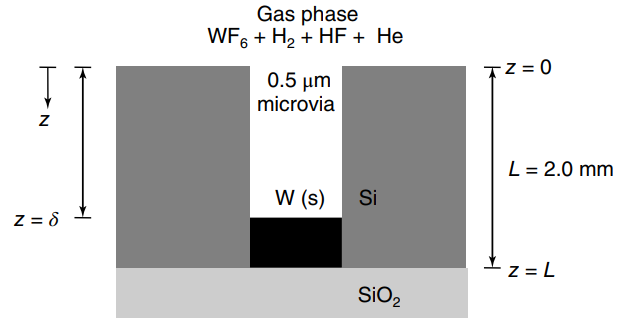Microvia are microscopic passages between two thin films on a microelectronic device. Often, microvia are filled with
Question:
WF6 (g) + 3H2 (g) †’ W(s) + 6 HF (g)
As the tungsten metal forms, it fills the microvia (2.0 µm depth, 0.5 µm diameter), as shown in the figure below. The tungsten metal does not coat the side walls of the microvia; it only grows upward from the base of the microvia where the tungsten was initially seeded. The reactants are significantly diluted in inert helium (He) gas to lower the deposition rate. The temperature is 700 K, the total system pressure is 75 Pa, and the composition of WF6 in the bulk gas space over the microvia is 0.001 mole%. Assume that the tungsten deposition rate is limited by molecular diffusion. The molecular weight of tungsten (W) is 184 g/mole, the molecular weight of fluorine is 19 g/mole, and the density of solid tungsten is 19.4 g/cm3.
a. Develop a pseudo-steady-state (PSS) molecular diffusion mass transfer model to predict the depth of tungsten metal within the microvia as a function of time.
b. Estimate time required to completely fill the microvia, assuming Knudsen diffusion for WF6 vapor at the low total system pressure of 75 Pa.
Step by Step Answer:

Fundamentals Of Momentum Heat And Mass Transfer
ISBN: 9781118947463
6th Edition
Authors: James Welty, Gregory L. Rorrer, David G. Foster





